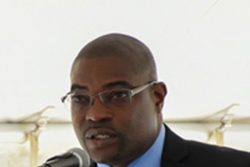By Samuel Brathwaite
Dr. Samuel Braithwaite is a Lecturer in the Department of Economics at The University of the West Indies, Mona. He is also a technical consultant at Growth Perspectives Ltd.
It was the best of times, it was the worst of times, it was the carnival of Lara’s brilliance, it was the crestfallen end of West Indian dominance of international cricket, it was the period of Ambrose and Walsh bowling match winning spells, it was the period when the Waugh brothers took the Frank Worrell trophy down under, it was the spring of hope, it was the winter of despair. The 1990s was the period when I began following West Indies Cricket earnestly. It was the period when Brian Charles Lara dominated the cricket world. Lara dominated the headlines, and not always for good reason.
Lara is quite likely the favourite cricketer of all time for many of my contemporaries who were similarly interested in the game. Curtly Ambrose is firmly in the position of favourite cricketer of all time for me. As a West Indian, Lara is like family; regardless of my dissatisfaction with aspects of his life, I am proud of his achievements. Around the middle of July, I heard of his new book (Lara: The England Chronicles) and had to get a copy, a hardcover copy. I expected controversy. This, after all, was the cricketer who held the West Indies Cricket Board to ransom en route to Mandela’s South Africa. This was the gentleman who lost a chance to show contrition when invited to give the MCC Spirit of Cricket Cowdrey Lecture at Lord’s in 2017. This was the cricketer who walked out on the West Indies team on the 1995 tour of England.
Lara’s story provides interesting and invaluable insights into what is needed for young cricketers to successfully conquer the highest levels of cricket. Ideally, it is these insights which should dominate the headlines, but alas, controversy sells. The fourth estate recognizes this. Lara recognizes this.
Lara spoke to his formative years growing up in “a once sleepy little village called Cantaro in the Santa Cruz valley.” The purity of the air, the simplicity of life, and a strong sense of community are some of the features which generally define village life. What stood out for me, but not in a surprising way, was Lara’s description of the food he ate. Fresh seafood, vegetables, and fruits (avocado his favourite) were readily available. It would make for an interesting study to understand the diet of our cricketers, in a region plagued by non-communicable diseases (rich world diseases) occasioned largely by the preponderance of over processed foods, much of which we import. Reading about Lara’s diet, I could not help but be reminded about Shamar Joseph and his life in rural Guyana. Unfortunately, Joseph did not have the cricketing resources available to a young Lara hence his belated entrance into cricket; Joseph lived several hours away by boat from the nearest town (New Amsterdam) while Lara was about half an hour away from Port of Spain. Joseph aside, we can all remember the global curiosity around the diet of Jamaican athletes when they dominated the world of sprint. Our culture, our food, can allow us to achieve great things.
Lara had the good fortune of spending his teenage years at the feet of Joey Carew, the former West Indies cricketer, and former captain of the Trinidad & Tobago senior side, which he led to regional cricket titles in 1971 and 1972. Carew also served for several years on the selection panel for the West Indies cricket team. The relationship between Carew and Lara was so deep and fruitful that when Carew’s name is mentioned Lara’s will quickly follow. Some will say that Carew’s greatest contribution to West Indies cricket is Lara.
During his time at Fatima College (where Carew’s sons attended) Lara became a member of the Carew household in Port-of-Spain. Lara benefitted from the cricket knowledge of Joey Carew and his sons, and the abundant supply of cricket literature scattered around the Carew house, but the icing on Lara’s time with the Carews is the access he had to many cricketers (Trinidad & Tobago and West Indies players) who would visit the Carew house. Living with the Carews meant that Lara was fully immersed in cricket, in ways he could never have dreamt of. Our current young cricketers are unlikely to benefit from the level of immersion into cricket Lara had. However, mentorship by our past cricketers, people who understand the pressures of life as a cricketer, people who can relate to the difficulties our young cricketers face, can be easily done with the wide availability of information and communication technologies.
Lara’s brilliance as a future test cricketer was quite evident from his teenage years. He made the West Indies Test squad in December of 1989 (Tour of Pakistan) at the age of 19 and made his Test debut on the same tour. The following year, aged 20, he captained the Trinidad & Tobago senior team. What is instructive, however, is that on the 1991 tour of England, Lara did not make the final 11 of the test side but played a few tour matches. His exclusion is indicative of the deep talent pool of West Indian batters. The talented Lara spent much time knocking at the door of the Test 11, fetching water and clean towels. Our current cricketers are quickly pushed into international cricket with great expectations on their inexperienced shoulders.
As for the controversial parts, Lara spoke his truth, as did Curtly Ambrose (Curtly Ambrose: Time to Talk), Michael Holding (Michael Holding: No Holding Back), and Clive Lloyd (Clive Lloyd: The Authorised Biography), to name a few. As an example, Lloyd was blunt in his assessment of the captaincy of the great Sobers, and I quote, “[e]verything on a player’s mind must be able to be aired at team meetings. We must work out what we are about. Everyone must be clear about that so when we take the field no one is in the slightest doubt about what is required of him and what is the team goal. Sobers failed in that.”
Lara was less careful when discussing his teammates, identifying specific players instead of leaving out names as Holding did in “No Holding Back.” Lara was also less careful in his assessments of past cricketers. The adverse reactions to his actions and utterances over the years do not seem to have given him pause. Sir Vivian Richards and Carl Hooper issued a joint statement condemning Lara’s description of the relationship between Richards and Hooper in his book. I do not recall Lara directly or indirectly offering a public comment in response to that joint statement. Perhaps some overtures were made in private, or perhaps Lara sees no reason to apologize. Whatever the facts are, Lara’s perception of the relationship between Hooper and Richards remains in print alongside his glowing commentary on Hooper’s beautiful technique as a batter. Was Lara deeply and quietly jealous of the relationship between Hooper and Richards? Your opinion is as good as mine.
Sir Curtly Ambrose was also not spared the wrath of Lara’s pen. Lara recalled an incident where he felt Ambrose was disrespectful to then captain Viv Richards by allegedly using threatening language. Richards had threatened that should Ambrose (he did not mention him by name) err again as he did on the field that day, he (Richards) would ensure that Ambrose never represented the West Indies again as long he (Richards) remained in charge. The disrespectful and threatening statement from Ambrose, according to Lara, went like this, “I know where you are from, we’re from the same island, I came here with nothing, and I will leave with nothing.” I will let the reader decide on the level of disrespect and threat contained in said statement. Was this Lara’s way of responding to the view in Ambrose’s book that Lara acted unprofessionally on the 1995 tour of England by abandoning the team? Was this Lara’s honest reflection on and perception of past events?
Perhaps Lara’s approach to dealing with his former teammates, decades after they shared dressing rooms across the world, offers a glimpse into why Lara could not get the best out of the team as Clive Lloyd did decades earlier. This in no way absolves various West Indies Cricket Boards of responsibility for the failings of the West Indies team.
To his credit, Lara did show some remorse. On the issue of his taking over as captain from Courtney Walsh, Lara writes, “[i]n those first weeks and months I never properly reached out to Courtney as I should have done. I think that was one of the things I was afraid to do, or perhaps, I just didn’t know how to do it. I regret that.” Lara was also candid about personal struggles stemming from his meteoric rise and the pressure to deliver. Like most West Indian men, Lara did not seem convinced about therapy. Credit to him for at least giving therapy a try, and for writing about it in his book.
I highly recommend Lara’s new book. It is balanced, candid, revealing, riveting, well-paced and therefore difficult to put down. There are scorecards at the end of some chapters which certainly help to transport the reader back to the events Lara writes about. One glaring omission from the book is an index, which I think necessary for a book which is likely to be used as a reference. The book omits or does not sufficiently treat with some critical and controversial parts of Lara’s career; these I expect to be covered in his next book. This was simply the start of the “Lara Chronicles”.









